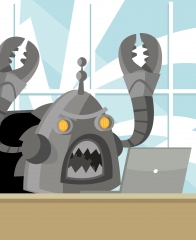 / The End(s) of Reading
Subscribe
/ The End(s) of Reading
Subscribe

For years, observers of our culture have been heralding, darkly, the death of reading. Yet, precisely because of the digital devices that go with us everywhere, those glowing screens that threaten to make traditional books and newspapers obsolete, aren’t we doing more reading now than ever before?
A quarter-century ago, writers such as Neil Postman, in Technopoly: The Surrender of Culture to Technology (1993) and Sven Birkerts, in The Gutenberg Elegies: The Fate of Reading in a Digital Age (1994), were already lamenting the decline of a “reading sensibility”—a mindset of attentiveness to language and logic, grounded in a collective memory of the past—amidst an onslaught of new media. Postman and Birkerts, for whom these “new” media were things like TV, audiobooks, and CD-ROMs, could scarcely have foreseen what was about to come. In the current flowering of the digital era, with the infinite distractions of the Internet constantly available on our devices, it often seems that we have lost the attention span to immerse ourselves in a magazine article, let alone a novel. Giant online retailers have killed the neighborhood bookstore, taking away a wellspring that once nourished our reading lives. And who has the time to read, anyway, when our jobs demand that we remain connected 24/7, the news cycle updates every few minutes, and our social-media personae require regular tending?
I am not here to refute Postman or Birkerts or subsequent thinkers (such as Sherry Turkle or Nicholas Carr) who have continued to warn of a dark side to the digital revolution, an atrophying of certain aspects of human communication and cognition. I’m inclined to agree, in fact, that something has been lost. Even as I use online research databases and other digital resources daily, I persistently hate reading on screens. I prize all the artifacts of the print age: the texture, smell, and weight of paper, the visual harmonies of typeface and layout. I still remember my surprise and disappointment on learning that the Amazon Kindle ignored the page design of printed books and offered only plain text in a choice of a few, dull fonts. Wow, I thought, those product designers really don’t understand reading.
Yet I can’t help but notice that in our daily lives, in this moment of the “death of reading,” most of us seem to do a lot more of certain kinds of reading, more interacting with the written word broadly defined, than we used to. Once, families tuned in to watch the nightly news on TV; now we read our news on websites and apps. Often we come to these news websites via links from Facebook and Twitter, one experience of reading leading on to another. Even when we do watch CNN, MSNBC, or Fox News, the screen is filled with things to read: logos, captions, banners, chyrons, category labels like “Breaking News” or “Developing Story,” and the ticker, the animated line running across the bottom of the screen that offers updates on stories other than the one being discussed in the main frame. At what point do the anchor and correspondents talking on the screen become background noise, and “watching” TV becomes mostly an act of reading the text superimposed on it?
Certainly, reading and writing have all but replaced talking on the telephone. It’s a rare person under 40 now who likes to pick up the phone and, in the phrase from the old AT&T ad, “Reach out and touch someone.” From ordering pizza and buying plane tickets, to making appointments with doctors and hairstylists, most people prefer to read and choose their options on a website rather than talk to anyone. My phone now offers the blessed silence of automatic transcription of voicemail to a block of words I can read. And who calls a friend these days to make or change plans? Instead, always and for everything, for flirting, for “could you pick up milk on the way home,” for news of deaths and births and public disaster warnings, we have texting, that constant stream of communication with intimates and strangers that unscrolls in perpetual stichomythia, those alternating lines of verse delivered in the dialogue of characters in Greek drama. People who live together sometimes even text each other from different rooms in the house, rather than shouting. Texting’s very name centers the primacy of text, of the typed word over the spoken one. With the undulating grey ellipsis that appears while your correspondent composes a message, the iPhone has even turned pure nothingness–the empty space of waiting–into a textual convention, into typography, into something to read.
That ellipsis, which Apple calls the “typing awareness indicator,” is only one of countless ways in which digital communications, such as texting and social media, have reshaped our language to make it more based in writtenness; they have even given birth to verbal idioms that are hybrids between text and speech. Take, for instance, the phenomenon of “pwn,” the common typo for “own,” which became slang for “soundly defeat” in online video gaming in the mid-2000s; it was an in-joke that depended on the fact that everyone in the group was communicating through a QWERTY keyboard. Online acronyms such as “lol” and “idk” have moved into speech. Among my students, I first heard these text-speak expressions uttered ironically, with invisible quotation marks around them, but later they seemed to become sincerely integrated into my students’ lexicon. Another text-based expression that transitioned into a spoken idiom isn’t a phoneme at all, but a typographical symbol. “Hashtag-blessed,” my students will say, with a sarcastic tilt, when they’ve been particularly unlucky, or “Hashtag-Wellesley” when they’ve had their noses to the academic grindstone. They’re parodying the Twitter/Instagram/Facebook convention of adding category tags to posts; they’re parodying the smug self-regard of much online self-representation; they’re enjoying the absurdity of vocalizing something purely textual; but at the same time, they’re creating a new kind of utterance that is deeply inflected by the written and the read.
All this is to say that reading and a readerly, textual sensibility are far from dead; instead, they seem to be insinuating themselves into, even replacing, our spoken communications and media at all levels. It’s true that this kind of reading looks different from the unplugged, immersive reading, the extended communion of book and mind, that I still prize above all others. But we would do well to remember that that kind of reading itself has a history; it is not natural, but culturally shaped. Reading in the European Middle Ages was typically a public activity. It took place out loud: in church services, in religious communities, at court entertainments. The book was a social medium. Sometime in the transition from medieval to early modern culture, with the advent of print and the spread of literacy, readers’ encounter with the book became more individual, private, and intimate. Reading turned silent, ceasing to involve the lips and tongue and becoming a work of the eye. At a pivotal moment of advance in media technologies, a time rather like our own, reading changed. Scholars have asked fascinating questions about what this shift meant for the rise of new genres like the novel, for the evolving idea of the author, for the history of cognition and brain function. Perhaps future historians will extend these inquiries into our time, in which a media revolution is again setting the world aspin, and the categories of the oral and the written seem to be losing their clear demarcation. The history of reading is still being written.






